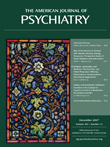Lateralized Caudate Metabolic Abnormalities in Adolescent Major Depressive Disorder: A Proton MR Spectroscopy Study
Abstract
Objective: Proton magnetic resonance spectroscopy ( 1 H-MRS) has been increasingly used to examine striatal neurochemistry in adult major depressive disorder. This study extends the use of this modality to pediatric major depression to test the hypothesis that adolescents with major depression have elevated concentrations of striatal choline and creatine and lower concentrations of N -acetylaspartate. Method: Fourteen adolescents (ages 12–19 years, eight female) who had major depressive disorder for at least 8 weeks and a severity score of 40 or higher on the Children’s Depression Rating Scale—Revised and 10 healthy comparison adolescents (six female) group-matched for gender, age, and handedness were enrolled. All underwent three-dimensional 3-T 1 H-MRS at high spatial resolution (0.75-cm 3 voxels). Relative levels of choline, creatine, and N -acetylaspartate in the left and right caudate, putamen, and thalamus were scaled into concentrations using phantom replacement, and levels were compared for the two cohorts. Results: Relative to comparison subjects, adolescents with major depressive disorder had significantly elevated concentrations of choline (2.11 mM versus 1.56 mM) and creatine (6.65 mM versus 5.26 mM) in the left caudate. No other neurochemical differences were observed between the groups. Conclusions: These findings most likely reflect accelerated membrane turnover and impaired metabolism in the left caudate. The results are consistent with prior imaging reports of focal and lateralized abnormalities in the caudate in adult major depression.



